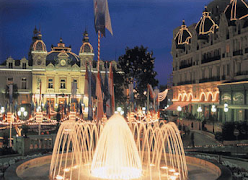France
Drive on the right hand side.
Emergency telephone number: Police 17, Fire 18 and Ambulance services 15 (dial the number given in the nearest call box or if no number given, call the police).
Speed limits: Motorways: 130kph (80mph)
Urban Stretches: 110kph (68mph) and 80pkh (49mph) on the Paris ring road
Dual carriageways: 110kph (68mph)
Outside built-up areas: 90kph (55mph)
Built-up Areas: 50khp (31mph)
In wet weather, lower speed limits apply in France:
80kph (49mph) outside built-up areas; 100kph (62mph) on dual carriageways; and 110kph (68mph) on motorways. These lower limits apply at all times to drivers who have held a licence for less than 2 years.
Tolls: France has a large amount of road tolls, especially on the main roads and motorways. The result of this though means generally clean and quality road systems.
If you are on a limited budget while travelling in your hire car, France has an excellent network of trunk roads. They are also known to the locals as routes nationals. There are no toll payments on these roads.
In your hire car: It is illegal to travel without a seat belt on.
Always have with you a warning triangle, flash light and first aid box.
Drink Driving: On the spot fines for drink driving and driving on a provisional licence can be awarded in France. A strict alcohol limit of 50 milligrams or 0.05% is enforced.
Parking and Resting Zones: Parking and resting zones for your hire car are situated every 10 to 20km on motorways and 24 hour petrol stations every 40km. Parking is forbidden in the centre of many major cities. Most towns have a ‘Zone Bleu’ parking area requiring a blue disk windscreen sticker, which can be bought from the local tobacconist or garage.
France has an extensive network of motorways or “autoroutes”. These can sometimes be free, particularly in and around large cities. Wherever there is an alternative route, however, they usually incur a fee depending on the distance travelled. These are “autoroutes a peage” and denoted with a blue sign. Credit cards are accepted but it is always worth having some change at the ready to pay for short distances. If you are travelling large distances, these can be pricey but are an extremely efficient way of getting around. For an alternative, more scenic route follow the “itinéraire Bis” signs
Whenturning left (across the oncoming traffic), you must often first turn right and follow a filter lane round, crossing the traffic via traffic lights or over/underpass. These types of turn are usually signposted ahead of the junction.
Unleaded petrol is known as “Sans Plomb 95 or 98) and diesel is “gasoil” - the cheapest place to fill up is usually the supermarket.
Be aware that the automatic petrol pumps (“pay at pump”) do not always accept international credit cards.
Be aware that rural petrol stations rarely open 24 hours
French signs usually give prominence to place names rather than identifying numbers. To help you navigate, be aware of which towns lie in the same direction as you are going. Large cities (such as Paris) can be signposted from many miles away and are often given prominence over smaller, closer towns. Common signs, particularly as methods for diverting traffic through towns are “Toutes directions” (All directions) and “Autres directions” (All other directions)
Snow chains must be fitted to vehicles using snow-covered roads in compliance with the relevant road signs
skip to main |
skip to sidebar
Search This Blog
October/octobre
This site is still under construction. Please check back regularly.
We love to hear your vacation stories about Nice. Please feel free to share them with us. We are also interested in special places you have found, great restaurants or just really nice trips you have taken in and around Nice.
send emails to residencenegrescorental@gmail.com
We love to hear your vacation stories about Nice. Please feel free to share them with us. We are also interested in special places you have found, great restaurants or just really nice trips you have taken in and around Nice.
send emails to residencenegrescorental@gmail.com





